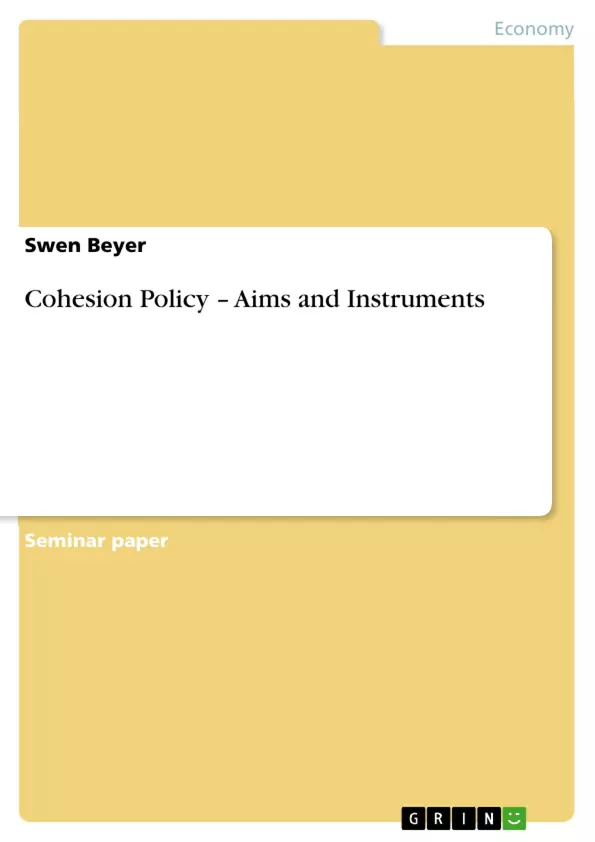Der Grundgedanke Europäischer Kohäsionspolitik ist es, wirtschaftliche und strukturelle Differenzen auf nationaler und regionaler Ebene zu harmonisieren. Um diese Defizite perspektivisch und gezielt zu beheben, hat die EU Kommission Fonds aufgesetzt. Die verschiedenen Arten der finanziellen Unterstützung und deren Handlungsrahmen wird auf den folgenden Seiten erläutert. Durch die Aufnahme der 10 neuer Länder in die EU 2004, steht die Europäische Kohäsionspolitik vor neuen Herausforderungen.
Inhaltsverzeichnis (Table of Contents)
- Introduction
- General Aims of Cohesion Policy
- Division of the EU areas
- Objective 1
- Objective 2
- Objective 3
- Elements/Instruments of European cohesion policy
- Cohesion Fund
- European Regional Development Fund (ERDF)
- European Social Fund (ESF)
- European Agricultural Guidance and Guarantee Fund (EAGGF)
- Instrument for Fisheries (FIFG)
- Cohesion policy for the period 2007-2013
Zielsetzung und Themenschwerpunkte (Objectives and Key Themes)
This paper discusses European cohesion policy and its aims, instruments, and challenges. It aims to provide an overview of the policy's history, objectives, and implementation. The paper explores how the policy has evolved to address changing needs within the European Union.
- Economic integration and cooperation between European countries
- Harmonizing economic and structural differences across national and regional levels
- Addressing disparities between regions within the EU
- The role of EU funds in supporting regional development
- The challenges posed by the enlargement of the EU
Zusammenfassung der Kapitel (Chapter Summaries)
The introduction outlines the purpose of European cohesion policy, highlighting the need to bridge economic and structural disparities between member states. It emphasizes the historical context of the policy and its ongoing relevance in light of economic inequalities within the European Union.
Chapter 2 elaborates on the general aims of cohesion policy, emphasizing its dual objectives: supporting lagging regions and balancing regional differences within member states. It also highlights the historical development of cohesion policy and its significance in addressing the "cohesion problem" resulting from economic disparities.
Chapter 3 delves into the division of EU areas into three categories, Objective 1, Objective 2, and Objective 3. It explains the criteria for each category and how funds are allocated based on specific needs. The chapter also discusses the funding priorities for each objective and the different types of programs supported.
Chapter 4 explores the various instruments of European cohesion policy, providing an overview of the key funds and programs. It explains how the EU funds work in conjunction with member state governments to support regional development.
Schlüsselwörter (Keywords)
European cohesion policy, economic integration, regional disparities, EU funds, structural funds, Objective 1, Objective 2, Objective 3, regional development, economic convergence, European Union, Maastricht Treaty, European Monetary Union.
- Quote paper
- Master of Science in Management Swen Beyer (Author), 2007, Cohesion Policy – Aims and Instruments, Munich, GRIN Verlag, https://www.grin.com/document/152760



